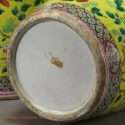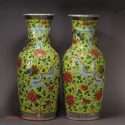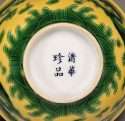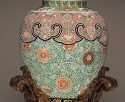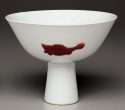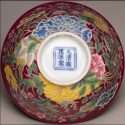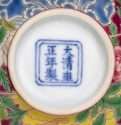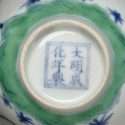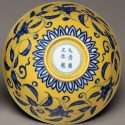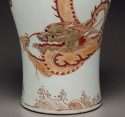Qing Enamel Porcelains
During the Qing Dynasty (1644-1911) in China the ranges of enamels available to the potter and decorator for fine porcelains and pottery had reached it's apex.
By the mid 18th C. the colors and combinations had become virtually limitless. Doucai, Wucai, Fencai, Famille Rose, Famille Noire, Famille Jaune, Sancai, under-glaze blue, over-glaze blue and on
and on, were being produced in combinations never seen before in China nor the rest of the world. By the start of the Qing dynasty the popularity of Qing Enamel Porcelains found wide acceptance and demand within China as well as in the middle-east, Europe and the America's. The evolution of colors peaked by the mid 1700's under the watchful eye of Tang Ying who had been appointed to run and manage the Imperial kilns during the Yongzheng reign and into the the early Qianlong period.
On this page are many examples produced routinely during this time for domestic use as well as pieces made for export to the west as well as some pieces made at the Imperial Kilns and often marked accordingly for the Emperors own use, or for those living in the Imperial Palaces.
- 19th C. Chinese Enamel Food Bowl
- 19th C. Chinese Enamel Food Bowl
- 19th C. Crackle Glazed Dish
- 19th C. Crackle Glazed Dish with Foo Lions
- 19th C. Famille Jaune Vase foot
- Pair 19th C. Famille Jaune Vases
- foot, Pair 19th C. Dragon Bowls
- Pair 19th C. Dragon Bowls with Fencai Enamels
- 18th C. Chinese Export Bowl for the Persian market
- 19th C. Chinese Enamel Covered Bowl
- foot, 19th C. Chinese Famille Jaune Famille Rose Planter
- 19th C. Famille Jaune Famille Rose Planter
- foot, 19th C. Chinese Kwan-yin
- 19th C. Chinese Kwan-yin
- foot detail, 19th C. Chinese Coral Red and Cobalt vase
- 19th C. Chinese Coral Red and Cobalt vase
- 18th C. Coral Red Chinese Bamboo Bowl, with reign mark
- 18th C. Coral Red Chinese Bamboo Bowl
- foot, 18th Chinese export teapot with en grisaille Decorations
- 18th Chinese export teapot with en grisaille Decorations
- 18th C. Chinese Export Sepia Eagle Cup and Saucer
- 19th C. Chinese mallet vase in Famille Rose decorations
- 18th C. Chinese Imari Creamer
- foot 18th C. Chinese Export Enamel Bird Plates
- 18th C. Chinese Export Enamel Bird Plates
- bases with Kangxi Marks, Pair 19th C. Chinese Enamel vases
- Pair 19th C. Chinese Enamel vases
- foot rim, 19th C. Iron red Chinese Lanterns
- 19th C. Iron red Chinese Lanterns
- 19th C. Crackle vase with Soldiers.
- Qianlong marked 19th C. Famille Jaune Cup
- 19th C. Famille Jaune Cup
- mark, 19th C. Chinese Foo Lion teapot
- 19th C. Chinese Foo Lion teapot
- base, 19th C. Chinese Doucai paste Box with Qianlong mark.
- 19th C. Chinese Doucai paste Box
- 19th C. Chinese Coral Red Zhadow
- base, 19th C. Chinese Famille Rose Mellon jar
- 19th C. Chinese Coral Red Zhadow
- 19th C. Chinese Famille Rose Mellon jar
- 18th C. Chinese Doucai Bottle
- 18th C. Chinese Doucai Bottle
- 18th C. Chinese Doucai Bottle
- Handle, 18th C. Imperial Qianlong Court Fan
- Detail, 18th C. Imperial Qianlong Court Fan
- 18th C. Imperial Qianlong Court Fan
- 19th C. Famille Noire vases
- Foot-rim, Chinese Famille Noire Dragon Bowl,
- 19th C. Chinese Famille Noire Dragon Bowl, interior view
- 19th C. Chinese Famille Noire Dragon Bowl.
- Qianlong Coral Red Bowl Reign Mark
- 19th C. Guangxu Famille Jaune Dragon Bowl
- 19th C. Guangxu Famille Jaune Dragon Bowl
- Detail, 18th C. Chinese Famille Verte Jar Gilt Bronze Mounts
- 18th C. Chinese Famille Verte Jar Gilt Bronze Mounts
- Chinese Yongzheng Stem Cup
- Chinese Yongzheng Stem Cup
- Footrim Detail, Chinese Yongzheng Docai Dish
- Detail, Chinese Yongzheng Docai Dish
- Chinese Yongzheng Docai Dish
- Chinese Yongzheng Enamel Bowl Reign mark
- Chinese Yongzheng Enamel Bowl
- Chinese Yongzheng Enamel Bowl
- Reign mark, Chinese Yongzheng Enamel Bowl
- Chinese Yongzheng Enamel Bowl
- Chinese Yongzheng Enamel Bowl
- Reign mark Chinese Yongzheng Doucai Enamel Bowl
- Large View, Chinese Yongzheng Doucai Enamel Bowl
- Chinese Yongzheng Doucai Enamel Bowl
- Chinese Yongzheng Palace Bowl, large view
- Chinese Yongzheng Palace Bowl, with reign mark
- Interior Chinese Yongzheng Palace Bowl, large view
- Interior Chinese Yongzheng Palace Bowl,Steele Collection
- Foot-detail Large View, 18th C. Dragon Meiping vase
- Large View, 18th C. Dragon Meiping vase
- 18th C. Chinese Dragon Meiping vase, Steele Collection
- foot, 19th C. Chinese Inscribed Teapot
- 19th C. Chinese Inscribed Teapot
- Inscription, 19th C. Chinese Inscribed Teapot
- 19th C. Chinese Inscribed Teapot





